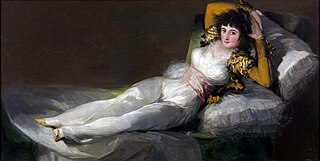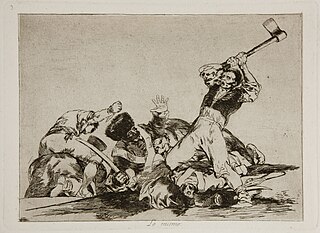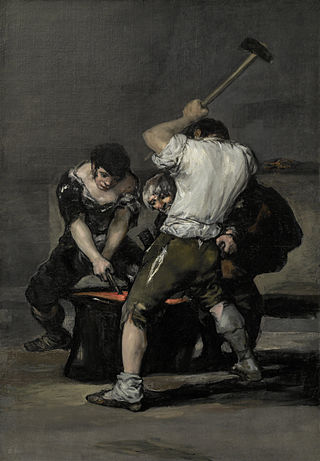
As a literary device or artistic form, an allegory is a narrative or visual representation in which a character, place, or event can be interpreted to represent a hidden meaning with moral or political significance. Authors have used allegory throughout history in all forms of art to illustrate or convey complex ideas and concepts in ways that are comprehensible or striking to its viewers, readers, or listeners.

Francisco José de Goya y Lucientes was a Spanish romantic painter and printmaker. He is considered the most important Spanish artist of the late 18th and early 19th centuries. His paintings, drawings, and engravings reflected contemporary historical upheavals and influenced important 19th- and 20th-century painters. Goya is often referred to as the last of the Old Masters and the first of the moderns.

Father Time is a personification of time. In recent centuries he is usually depicted as an elderly bearded man, sometimes with wings, dressed in a robe and carrying a scythe and an hourglass or other timekeeping device.

The Countess of Chinchon is an oil-on-canvas portrait painted ca. 1800 by the Spanish artist Francisco Goya. It is held in the Museo del Prado, Madrid. The painting depicts María Teresa de Borbón, 15th Countess of Chinchón, who had been encouraged by Queen Maria Luisa of Parma and by opportunism to marry Manuel de Godoy, the Prime Minister, in a marriage of convenience. It does not depict the more famous Countess of Chinchón who became the namesake of the cinchona genus of trees and shrubs responsible for early modern quinine production.

The Art of Painting, also known as The Allegory of Painting, or Painter in his Studio, is a 17th-century oil on canvas painting by Dutch painter Johannes Vermeer. It is owned by the Austrian Republic and is on display in the Kunsthistorisches Museum in Vienna.

La maja vestida is an oil painting on canvas created between 1800 and 1807 by the Spanish Romantic painter and printmaker Francisco Goya. It is a clothed version of the earlier La maja desnuda, which was created between 1795 and 1800. The identity of the model and that of the commissioner have not been confirmed. However, art historians and scholars have suggested she is María Cayetana de Silva or Godoy's mistress Pepita Tudó. The Clothed Maja was created during the peak of Romanticism.

Vicente López Portaña was a Spanish painter, considered one of the best portrait painters of his time.

Saturn Devouring His Son is a painting by Spanish artist Francisco Goya. It is traditionally interpreted as a depiction of the Greek myth of the Titan Cronus eating one of his offspring. Fearing a prophecy foretold by Gaea that predicted he would be overthrown by one of his children, Saturn ate each one upon their birth. The work is one of the 14 so-called Black Paintings that Goya painted directly on the walls of his house sometime between 1820 and 1823. It was transferred to canvas after Goya's death and is now in the Museo del Prado in Madrid.

The Disasters of War is a series of 82 prints created between 1810 and 1820 by the Spanish painter and printmaker Francisco Goya (1746–1828). Although Goya did not make known his intention when creating the plates, art historians view them as a visual protest against the violence of the 1808 Dos de Mayo Uprising, the subsequent Peninsular War of 1808–1814 and the setbacks to the liberal cause following the restoration of the Bourbon monarchy in 1814. During the conflicts between Napoleon's French Empire and Spain, Goya retained his position as first court painter to the Spanish crown and continued to produce portraits of the Spanish and French rulers. Although deeply affected by the war, he kept private his thoughts on the art he produced in response to the conflict and its aftermath.

The Sleep of Reason Produces Monsters or The Dream of Reason Produces Monsters is an aquatint by the Spanish painter and printmaker Francisco Goya. Created between 1797 and 1799 for the Diario de Madrid, it is the 43rd of the 80 aquatints making up the satirical Los caprichos.

The Colossus, is known in Spanish as El Coloso and also El Gigante, El Pánico and La Tormenta. It is a painting traditionally attributed to Francisco de Goya that shows a giant in the centre of the canvas walking towards the left hand side of the picture. Mountains obscure his legs up to his thighs and clouds surround his body; the giant appears to be adopting an aggressive posture as he is holding one of his fists up at shoulder height. A dark valley containing a crowd of people and herds of cattle fleeing in all directions occupies the lower third of the painting.

The Forge is a c. 1817 painting by Francisco Goya (1746–1828), today housed in the Frick Collection in New York City. The large oil on canvas represents three blacksmiths toiling over an anvil, and has been described by the art historian Fred Licht as "undoubtedly the most complete statement of Goya's late style."

Fight with Cudgels, called The Strangers or Cowherds in the inventories, is the name given to a painting by Spanish artist Francisco Goya, now in the Museo del Prado, Madrid. One of the series of Black Paintings Goya painted directly onto the walls of his house sometime between 1820 and 1823, it depicts two men fighting one another with cudgels, as they seem to be trapped knee-deep in a quagmire of mud or sand.

The Inquisition Tribunal, also known as The Court of the Inquisition or The Inquisition Scene, is a 46-by-73-centimetre oil-on-panel painting produced by the Spanish artist Francisco Goya between 1812 and 1819. The painting belongs to a series which also includes Bullfight, The Madhouse and A Procession of Flagellants, all reflecting customs which liberals objected to and wished were abandoned, but their reform was opposed by the absolutist (autocratic) policy of Ferdinand VII of Spain.

Hispania is the national personification of Spain.

The Portrait of the Duke of Wellington is a painting by the Spanish artist Francisco de Goya of the British general Arthur Wellesley, 1st Duke of Wellington, during the latter's service in the Peninsular War. One of three portraits Goya painted of Wellington, it was begun in August 1812 after the subject's entry into Madrid, showing him as an earl in an all-red uniform and wearing the Peninsular Medal. The artist then modified it in 1814 to show him in full dress uniform with black gold–braided lapels and to add the Order of the Golden Fleece and Military Gold Cross with three clasps.

The Black Duchess is a 1797 oil-on-canvas painting by Spanish painter Francisco Goya. The subject of the painting is María Cayetana de Silva, 13th Duchess of Alba, then 35 years old. It is a companion piece to the more chaste The White Duchess, completed two years earlier.

Allegory of Industry is a tondo painted by Francisco de Goya which was one of the four paintings from a series of allegories about scientific and economic progress, which decorated a waiting room of the residence of Manuel Godoy, Prime Minister of Spain during the reign of Charles IV. Since 1932, the picture has been in the Museo del Prado. The image shows two young women as they thread their respective spinning wheels in a semi-darkened room, illuminated by a large window which opens from the left. At the back, in the dark, one can discern uncertain faces of old women. The uncertainty of these women doesn’t reveal whether or not they are factor workers or representations of the tapestry or canvas.

The Portrait of the Marchioness of Santa Cruz or Portrait of the Marquise of Santa Cruz is an 1805 portrait by the Spanish artist Francisco José de Goya y Lucientes, a family friend of the subject. It has been owned by the Museo del Prado since 1986, when it bought it from its previous owner for over US$6 million.

This painting's Spanish title "La Aguadora" has various translations in English, The Water Bearer, Young Woman with a Pitcher, or the Water Carrier. It is an oil on canvas painting by Francisco de Goya, now in the Museum of Fine Arts in Budapest.






















